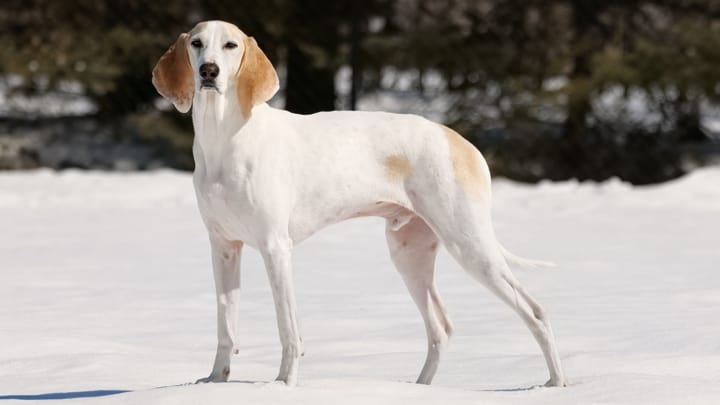Porcelaine
Other names : Chien de franche-comté, French Scent Hound

The Porcelaine is, primarily, a hunting dog - but what makes it stand out from the rest is its sheer love and affection towards its family. Warm, loyal and affectionate yet active, energetic and intelligent, you could call it the perfect hunting companion!
The Porcelaine loves company and is prone to separation anxiety. On top of this, it also has a particularly high exercise requirement. Therefore, a dog of this breed is best placed with an owner who’s around most of the time and who enjoys an active lifestyle.
|
Life expectancy |
The Porcelaine has a life expectancy of between 10 and 12 years |
|
Temperament |
|
|
Size |
Medium
|
|
Adult size |
Female
Between 21 and 22 in
Male
Between 22 and 23 in
|
|
Adult weight |
Female
Between 44 and 55 lb
Male
Between 66 and 55 lb
|
|
Coat colour
White, sometimes with orange marks. Orange speckles in the ears. |
White Black |
|
Type of coat
Single, shiny, glossy, fine yet thick. |
Short Hard |
|
Eye colour
Dark eyes |
Brown
|
The breed’s name, Porcelaine, was inspired by its glossy, glass-like white coat.
More details about the Porcelaine
Porcelaine: Origins and history
The Porcelaine is thought to be one of the oldest French scent hounds in existence today, believed to date back to 1845. Today, numbers of the breed are low but breed lovers in France are working to revive it.
Physical characteristics of the Porcelaine
The Porcelaine is well-proportioned, medium-sized dog with slender shoulders, long legs, deep chest and a medium-length, tapered tail. The Porcelaine is best known for its glossy, shining white coat which, from a distance, looks like glass. As hounds go, this breed is rather unique, with adorable long, large, floppy ears, wide black nose and dark, kind-looking eyes. The head is slim, the muzzle is long and the forehead is flat.
FCI classification of the Porcelaine
-
Group 6 - Scent hounds and related breeds
-
Section 1 : Scent hounds
Porcelaine: Characteristics
Porcelaine: Behaviour
Training a Porcelaine
The Porcelaine is easier to train than most hounds, but its needs must be met to keep its attention. Ideally, it needs a trainer who has experience with willful dogs who can help the Porcelaine grow into the sweet-natured, obedient pup it’s so capable of being.
Porcelaine: Lifestyle
Breed compatibility Porcelaine
Porcelaine: Purchase price
It is extremely rare in the UK. We do not have enough data to set an average price.
Looking after a dog of this size typically costs between £90 to £150 a month, including food, medical/insurance, and incidental expenses.
Porcelaine: Shedding
Average
Moderate, with seasonal moults.
Porcelaine: Grooming
Thankfully, the Porcelaine’s coat, although beautiful, doesn’t take much upkeep - a weekly brush to remove dead hairs will suffice. The long ears will need checking and cleaning regularly to prevent infection, as well as thorough drying after swimming of bathing. This breed also has fast-growing, thick claws which will need trimming every few months.
Porcelaine: Health
The life expectancy of a Porcelaine dog is 11 years.
The Porcelaine is a strong, sturdy and robust working dog.
Due to this dog’s single coat, it can tolerate heat quite well. However, it should always have access to cold water and shade.
Unfortunately, the Porcelaine doesn’t have a waterproof or thick coat to protect it from very cold weather, but its tenacity and determination will help to withstand most climates.
Although the Porcelaine isn’t known to be particularly prone to obesity, they should still be fed a balanced, high-quality diet and be exercised thoroughly.
- Hip Dysplasia
- Ear Infections
- Stomach torsion


